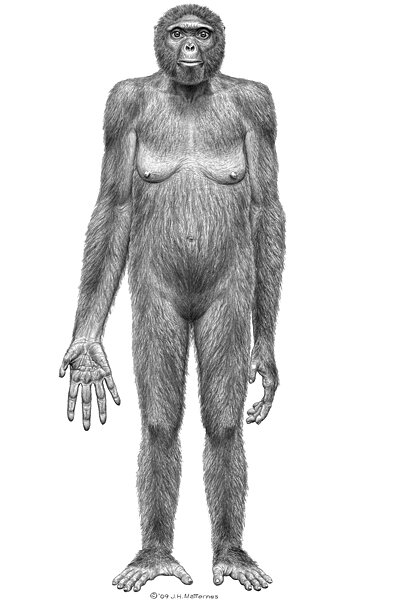Based on Analysis of Ardipithecus Ramidus Which of the Following
This supports other research which concluded that human ancestors were never knuckle-walkers which seems to be a later development in chimps and gorillas. The morphometric affinities of the Ar.

Representative Examples Of The Aramis Ardipithecus Ramidus Dentition Download Scientific Diagram
Ardipithecus ramidus the two tuffs are fossiliferous sediments averag-ing 3 m in thickness and cropping out discon-tinuously over an arc-shaped natural erosional transect of 9 km 28.

. All known hominin pelves with the exclusion of Ardipithecus ramidus Lovejoy et al 2009b share a suite of adaptations for bipedal locomotion in the true and false pelvis Lovejoy et al 1973. The purpose of the following sections is to analyze Pan Troglodytes Ardipithecus Ramidus and Australopithecus in order to determine any similarities and differences in their capacity for language based on the criteria mentioned above. Carbon-14 analysis cannot provide accurate date estimates that far into the past.
The pelvis reconstructed from a crushed specimen is said to show adaptations that combine tree. Ramidus shared by both Sahelanthropus and Australopithecus. Ardipithecus ramidus is a species of australopithecine from the Afar region of Early Pliocene Ethiopia 44 million years ago mya.
Comment on the Paleoenvironment of Ardipithecus ramidus Thure E. Functional analyses of the 44 Ma hominin Ardipithecus ramidus postcrania revealed a previously unknown and unpredicted locomotor pattern combining arboreal clambering and a form of terrestrial bipedality. Described 16 years ago White et al.
Longer hind limbs for clinging and leaping. Paleontologists discovered the fossil between 1994 and 1997 when it was excavated White 2016. Micro-CTbased evaluations of the Ar.
Palms and feet to move along tree branches. They dated the skeleton at 44 million years old being among 100 specimens from the species Ardipithecus. Initial behavioral analysis indicated that Ardipithecus could be very similar to chimpanzees however more recent analysis based on canine size and lack of canine sexual dimorphism indicates that Ardipithecus was characterised by reduced aggression and that they more closely resemble bonobos.
The foot bones in this skeleton indicate a divergent large toe combined with a rigid foot its still unclear what this means concerning bipedal behavior. How the Laetoli footprints found in Africa support the conclusion that Australopithecus was a biped. Chimps-- Neither Is An Offshoot Of Ardipithecus Ramidus.
Science 328 1105 2010. The existence of multiple contemporaneous hominid species We know that Ardipithecus ramidus walked upright on the basis of its preserved foramen magnum The most significant behavioral distinction that can be made between Homo habilis and the australopithecines is the formers reliance on stone tools Could be wrong Sets found in the same folder. While studying for your physical anthropology midterm your classmate tells you that the bones of Lucy a famous australopithecine specimen that dates to about 32 million years ago were dated based on carbon-14 analysis.
The Pliocene 44 Ma hominoid species Ardipithecus ramidus has been linked phylogenetically to the Australopithecus Homo clade by nonhoning canines a short basicranium and postcranial features related to bipedality. The Tectonic Impact On. Ramidus foot were evaluated by constructing a morphospace based on six geometric mean-standardized variables that are preserved in the ARA-VP-6500 foot skeleton using Principal Components Analysis PCA Figure 2.
The skeleton was discovered in the Afar Rift valley in Ethiopia. Analysis of her skeleton has revealed that the 12m 4ft-tall hominid weighing about 50kg 110lb walked upright and possessed characteristics linked with Australopithecus the hominid genus that followed her. Ardi is a short form of a female hominid skeleton Ardipithecus ramidus.
You note that this is incorrect because. More than a million-years older than Lucy Ardipithecus ramidus and the associated fossils provide the most detailed snapshot of early hominid life. Fossil Analysis Pushes Back Human Split From Other Primates By 2 Million Years.
Long phalanges to wrap around tree branches. Eurygnathohippus Woldegabrieli Is A New Species Of Horse 44 Million Years Old. The analysis shows that Ardipithecus were fully upright bipeds although lacked foot arches and they showed no adaptations for knuckle walking but did have adaptations for tree climbing.
If you wish to distribute this article to others you can order high-quality copies for your colleagues clients or customers by clicking here. Ramidus cranial base confirm a derived basicranium of Ar. Ardipithecus ramidus was first reported in 1994.
Ardipithecus ramiduss intermediate form of bipedality included the use of. A partial skeleton of Ardipithecus ramidus nicknamed Ardi provides much of the basis for these claims. In 2009 scientists announced a partial skeleton nicknamed Ardi.
Our comparative analyses of P. This primary reason this fossil is so important and is one of my favorites is because it bridges the gap between the late fossil apes of the Miocene Epoch 25 million years. Paniscus suggest that this probably reflects basicranial organization unique to the hominid clade.
Ramidus unlike modern hominids has adaptations for both walking on two legs bipedality and life in the trees arboreality. 101126science1185274 This copy is for your personal non-commercial use only. One of the most important fossils in the study of human origins is Ardipithecus ramidus a fossil pre-human discovered in 1994 in what was once a forest in the Aramis region of northern Ethiopia.
Meet Ardipithecus Ramidus- Early Hominid Common Ancestor Was Neither Chimp Nor Human Says Study. Ardipithecus ramidus recovered in ecologically and temporally resolved contexts in Ethiopias Afar Rift now illuminates earlier hominid paleobiology and aspects of extant African ape evolution. This species is not the oldest known human ancestor and it was initially.
The 44 million-years-old specimens belong to the species. The rich fossil and geologic data from these units provide a detailed characterization of the Pliocene African land-scape inhabited by Ardipithecus. More than 110 specimens recovered from 44-million-year-old sediments include a partial skeleton with much of the skull hands feet limbs and pelvis.

Did Ardipithecus Ramidus Roam The Woods Or The Grasslands Csmonitor Com

Comments
Post a Comment